Sequential morphological characteristics of murine fetal liver hematopoietic microenvironment in Swiss Webster mice
- PMID: 21541657
- PMCID: PMC3102842
- DOI: 10.1007/s00441-011-1170-1
Sequential morphological characteristics of murine fetal liver hematopoietic microenvironment in Swiss Webster mice
Abstract
Embryonic hematopoiesis occurs via dynamic development with cells migrating into various organs. Fetal liver is the main hematopoietic organ responsible for hematopoietic cell expansion during embryologic development. We describe the morphological sequential characteristics of murine fetal liver niches that favor the settlement and migration of hematopoietic cells from 12 days post-coitum (dpc) to 0 day post-partum. Liver sections were stained with hematoxylin and eosin, Lennert's Giemsa, Sirius Red pH 10.2, Gomori's Reticulin, and Periodic Acid Schiff/Alcian Blue pH 1.0 and pH 2.5 and were analyzed by bright-field microscopy. Indirect imunohistochemistry for fibronectin, matrix metalloproteinase-1 (MMP-1), and MMP-9 and histochemistry for naphthol AS-D chloroacetate esterase (NCAE) were analyzed by confocal microscopy. The results showed that fibronectin was related to the promotion of hepatocyte and trabecular differentiation; reticular fibers did not appear to participate in fetal hematopoiesis but contributed to the physical support of the liver after 18 dpc. During the immature phase, hepatocytes acted as the fundamental stroma for the erythroid lineage. The appearance of myeloid cells in the liver was related to perivascular and subcapsular collagen, and NCAE preceded MMP-1 expression in neutrophils, an occurrence that appeared to contribute to their liver evasion. Thus, the murine fetal liver during ontogenesis shows two different phases: one immature and mainly endodermic (<14 dpc) and the other more developed (endodermic-mesenchymal; >15 dpc) with the maturation of hepatocytes, a better definition of trabecular pattern, and an increase in the connective tissue in the capsule, portal spaces, and liver parenchyma. The decrease of hepatic hematopoiesis (migration) coincides with hepatic maturation.
Figures

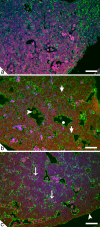

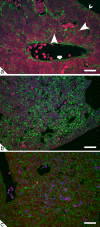
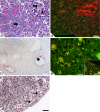

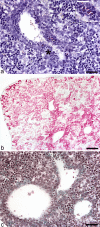

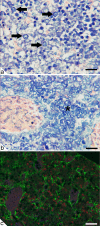
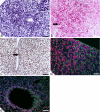
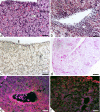

Similar articles
-
Immature hematopoietic stem cells undergo maturation in the fetal liver.Development. 2012 Oct;139(19):3521-30. doi: 10.1242/dev.079210. Epub 2012 Aug 16. Development. 2012. PMID: 22899849
-
Calomys callosus: an alternative model to study fibrosis in schistosomiasis mansoni. The pathology of the acute phase.Mem Inst Oswaldo Cruz. 1995 Mar-Apr;90(2):311-8. doi: 10.1590/s0074-02761995000200034. Mem Inst Oswaldo Cruz. 1995. PMID: 8531679
-
Fetal liver stroma consists of cells in epithelial-to-mesenchymal transition.Blood. 2003 Apr 15;101(8):2973-82. doi: 10.1182/blood-2002-05-1341. Epub 2002 Dec 27. Blood. 2003. PMID: 12506029
-
Embryonic hematopoiesis.Blood Cells Mol Dis. 2013 Dec;51(4):226-31. doi: 10.1016/j.bcmd.2013.08.004. Epub 2013 Sep 13. Blood Cells Mol Dis. 2013. PMID: 24041595 Review.
-
The regulatory role of stromal microenvironments in fetal hematopoietic ontogeny.Stem Cell Rev. 2006;2(3):241-6. doi: 10.1007/s12015-006-0052-5. Stem Cell Rev. 2006. PMID: 17625260 Review.
Cited by
-
Single-cell analysis of murine long-term hematopoietic stem cells reveals distinct patterns of gene expression during fetal migration.PLoS One. 2012;7(1):e30542. doi: 10.1371/journal.pone.0030542. Epub 2012 Jan 20. PLoS One. 2012. PMID: 22276210 Free PMC article.
-
The Fetal-to-Adult Hematopoietic Stem Cell Transition and its Role in Childhood Hematopoietic Malignancies.Stem Cell Rev Rep. 2021 Dec;17(6):2059-2080. doi: 10.1007/s12015-021-10230-x. Epub 2021 Aug 23. Stem Cell Rev Rep. 2021. PMID: 34424480 Free PMC article. Review.
-
Lectin-based carbohydrate profile of megakaryocytes in murine fetal liver during development.Sci Rep. 2023 Apr 25;13(1):6729. doi: 10.1038/s41598-023-32863-3. Sci Rep. 2023. PMID: 37185919 Free PMC article.
-
Localized SCF and IGF-1 secretion enhances erythropoiesis in the spleen of murine embryos.Biol Open. 2015 Apr 17;4(5):596-607. doi: 10.1242/bio.201410686. Biol Open. 2015. PMID: 25887124 Free PMC article.
-
Survival Motor Neuron (SMN) protein is required for normal mouse liver development.Sci Rep. 2016 Oct 4;6:34635. doi: 10.1038/srep34635. Sci Rep. 2016. PMID: 27698380 Free PMC article.
References
-
- Andrade ZA. Esquistosomiasis hepática: aspectos morfológicos. In: Popper H, Schaffner F, editors. Progresos en patología hepática, vol II. Barcelona: Editorial Científico Médica; 1967. pp. 249–264.
-
- Arias MA, Stewart A. Molecular principles of animal development. Oxford: Oxford University Press; 2002.
-
- Bogomoletz W. Advantages of the Sirius red staining method for amyloid and eosinophils. Arch Anat Cytol Pathol. 1980;28:252–253. - PubMed
Publication types
MeSH terms
LinkOut - more resources
Full Text Sources
Other Literature Sources
Molecular Biology Databases
Research Materials
Miscellaneous

